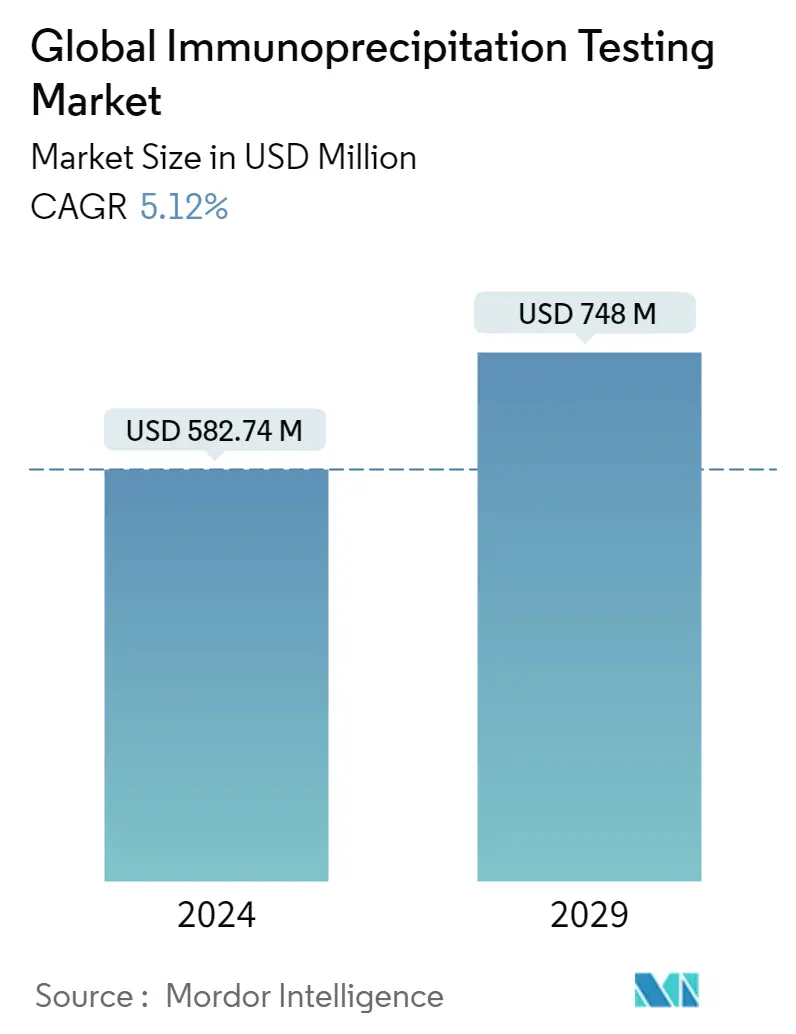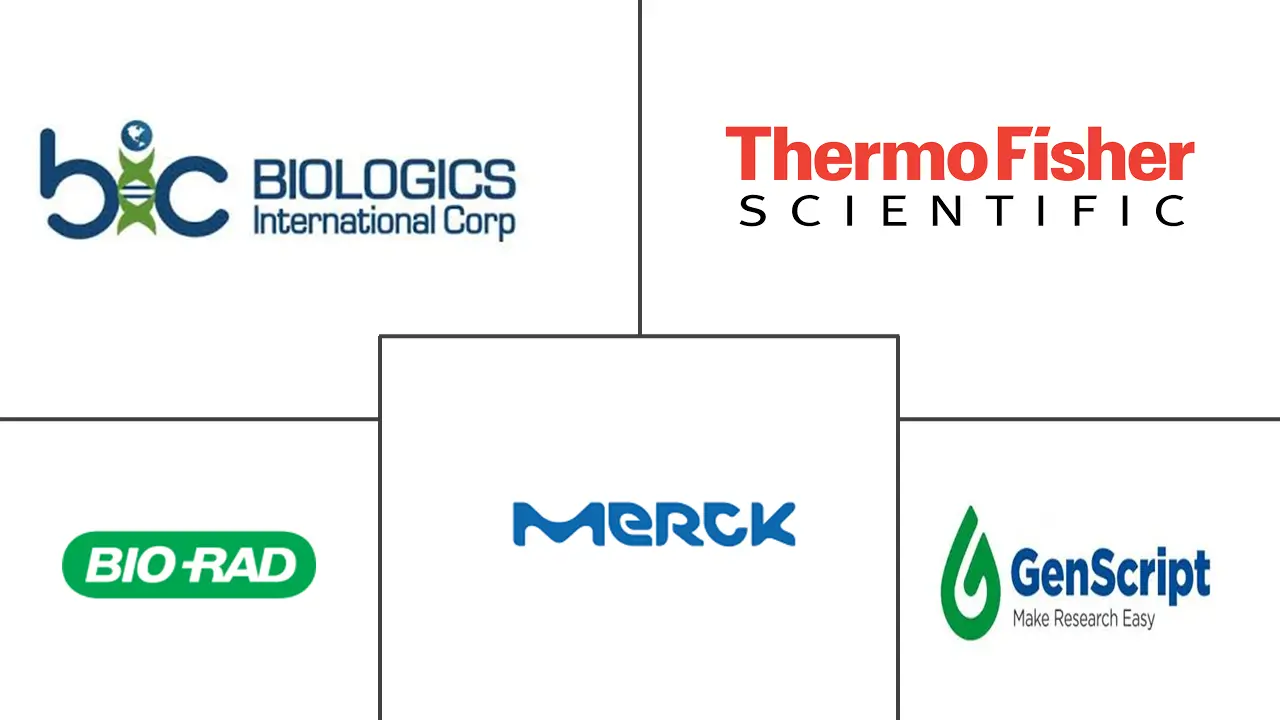Market Size of Global Immunoprecipitation Testing Industry

| Study Period | 2019 - 2029 |
| Market Size (2024) | USD 582.74 Million |
| Market Size (2029) | USD 748.00 Million |
| CAGR (2024 - 2029) | 5.12 % |
| Fastest Growing Market | Asia Pacific |
| Largest Market | North America |
Major Players
*Disclaimer: Major Players sorted in no particular order |
Immunoprecipitation Testing Market Analysis
The Global Immunoprecipitation Testing Market size is estimated at USD 582.74 million in 2024, and is expected to reach USD 748 million by 2029, growing at a CAGR of 5.12% during the forecast period (2024-2029).
The COVID-19 pandemic is expected to have a significant impact on the growth of the studied market. The coronavirus enters the cell when viral spike protein binds to the ACE2 protein present on the surface of human cells. Immunity among the COVID-19 recovered patients is predicted to develop due to the presence of neutralizing antibodies that block this binding. Hence, researchers study the protein interactions and action of neutralizing antibodies. For instance, as per the research study published in Science Daily in December 2020, titled 'Plasma From Recovered COVID-19 Patients Inhibits Spike Protein Binding to ACE2 in a Microsphere-Based Inhibition Assay', researchers applied immunoprecipitation associated with flow cytometry (IP-FCM) in studying the interactions of proteins in SARS-CoV2 infection and the role of antibodies in blocking the virus from binding to cells. Thus, given the ongoing pandemic and increasing research activities, the studied market is expected to be significantly impacted by the current crisis.
The immunoprecipitation testing market is increasing due to the prevalence of autoimmune disorders, which require antibody-antigen interaction testing. Additionally, the growing opportunities in funding and investments from the government and non-government organizations toward the research on next-generation DNA sequencing and genomics are fueling the market growth. In February 2021, the National Institute of Allergy and Infectious Diseases (NIAID) initiated a Phase 1 clinical study to evaluate the safety and immunogenicity of an Epstein-Barr Virus (EBV) gp350-Ferritin Nanoparticle Vaccine, in which the secondary immunogenicity endpoints are measured using luciferase immunoprecipitation assay.
The growing applications of immunoprecipitation testing in central nervous disorders, cancers, and cardiovascular diseases are also boosting the growth of the immunoprecipitation testing market. The tumor cells resistant to drugs exhibit dynamic protein-protein interactions; immunoprecipitation testing aids in studying these interactions among cancer patients. According to the Globocan 2020 fact sheet, an estimated 19,292,789 new cancer cases were diagnosed worldwide, with nearly 9,958,133 deaths from cancer globally. According to estimates from the International Agency for Research on Cancer (IARC), by 2040, the global burden of cancers is expected to grow to 27.5 million new cancer cases and 16.3 million deaths worldwide. Thus, the growing burden of cancers is also expected to drive market growth.
Additionally, in May 2019, Merck & Co. Inc. established a new life science facility that is majorly aimed at research and development activities related to oncology, immunology, and immuno-oncology.
However, limitations in sample size and variations in lipid content might hamper the wide application of this test, which is expected to impede the market growth.
Immunoprecipitation Testing Industry Segmentation
As per the scope of this report, immunoprecipitation (IP) is a precipitation procedure that purifies and enriches the selected protein by allowing the identification of protein-protein interactions in proteomics workflows. Immunoprecipitation is one of the major tools used in identifying the presence and size of proteins and studying downregulation or up-regulation, relative abundance, post-translational modifications (PTMs), stability, and interactions between proteins. The immunoprecipitation testing market is segmented by Type (Individual Protein Immunoprecipitation, Co-immunoprecipitation (Co-IP), Chromatin Immunoprecipitation (ChIP), RNA Immunoprecipitation (RIP), and Other Types), End User (Pharmaceutical and Biotechnology Industries, Contract Research Organizations (CROs), and Academic and Research Institutes), and Geography (North America, Europe, Asia-Pacific, Middle East, and Africa, and South America). The market report also covers the estimated market sizes and trends for 17 countries across major global regions. The report offers the value (in USD million) for the above segments.
| By Type | |
| Individual protein immunoprecipitation | |
| Co-Immunoprecipitation (Co-IP) | |
| Chromatin Immunoprecipitation (ChIP) | |
| RNA Immunoprecipitation (RIP) | |
| Other Types |
| By End User | |
| Pharmaceutical and Biotechnology Industries | |
| Contract Research Organizations (CRO's) | |
| Academic and Research Institutes |
| Geography | ||||||||
| ||||||||
| ||||||||
| ||||||||
| ||||||||
|
Global Immunoprecipitation Testing Market Size Summary
The immunoprecipitation testing market is poised for significant growth, driven by the increasing prevalence of autoimmune disorders and the rising demand for antibody-antigen interaction testing. The market is further bolstered by substantial funding and investments from both government and non-government organizations, particularly in the realms of next-generation DNA sequencing and genomics research. The ongoing COVID-19 pandemic has also played a crucial role in shaping the market, as researchers have leveraged immunoprecipitation techniques to study protein interactions and the action of neutralizing antibodies. This has led to heightened research activities, particularly in understanding the virus's binding mechanisms and the development of vaccines. The market's expansion is also supported by its growing applications in central nervous disorders, cancers, and cardiovascular diseases, where immunoprecipitation testing aids in studying dynamic protein-protein interactions, especially in drug-resistant tumor cells.
North America dominates the immunoprecipitation testing market, fueled by increased investments and government support in biotechnology research, alongside a strong focus on personalized medicine. The region benefits from a high concentration of key players and collaborative efforts between organizations and academic institutions. Despite the pandemic's impact on other biological product developments, the region continues to witness significant growth due to extensive research on COVID-19 and autoimmune disorders. The market is characterized by moderate competition, with major players like Merck KGaA, Thermo Fisher Scientific, and Bio-Rad Laboratories expanding their product portfolios through strategic initiatives. Technological advancements, such as Chromatrap technology, are enhancing the accuracy and efficiency of immunoprecipitation techniques, further propelling market growth.
Global Immunoprecipitation Testing Market Size - Table of Contents
-
1. MARKET DYNAMICS
-
1.1 Market Overview
-
1.2 Market Drivers
-
1.2.1 Rising Research and Development Activities in Life-sciences
-
1.2.2 Increasing Need to Identify Antigens Associated With Autoimmune Diseases
-
-
1.3 Market Restraints
-
1.3.1 Availability of Alternative Techniques
-
-
1.4 Porter's Five Forces Analysis
-
1.4.1 Threat of New Entrants
-
1.4.2 Bargaining Power of Buyers/Consumers
-
1.4.3 Bargaining Power of Suppliers
-
1.4.4 Threat of Substitute Products
-
1.4.5 Intensity of Competitive Rivalry
-
-
-
2. MARKET SEGMENTATION (Market Size by Value - USD million)
-
2.1 By Type
-
2.1.1 Individual protein immunoprecipitation
-
2.1.2 Co-Immunoprecipitation (Co-IP)
-
2.1.3 Chromatin Immunoprecipitation (ChIP)
-
2.1.4 RNA Immunoprecipitation (RIP)
-
2.1.5 Other Types
-
-
2.2 By End User
-
2.2.1 Pharmaceutical and Biotechnology Industries
-
2.2.2 Contract Research Organizations (CRO's)
-
2.2.3 Academic and Research Institutes
-
-
2.3 Geography
-
2.3.1 North America
-
2.3.1.1 United States
-
2.3.1.2 Canada
-
2.3.1.3 Mexico
-
-
2.3.2 Europe
-
2.3.2.1 Germany
-
2.3.2.2 United Kingdom
-
2.3.2.3 France
-
2.3.2.4 Italy
-
2.3.2.5 Spain
-
2.3.2.6 Rest of Europe
-
-
2.3.3 Asia-Pacific
-
2.3.3.1 China
-
2.3.3.2 Japan
-
2.3.3.3 India
-
2.3.3.4 Australia
-
2.3.3.5 South Korea
-
2.3.3.6 Rest of Asia-Pacific
-
-
2.3.4 Middle-East and Africa
-
2.3.4.1 GCC
-
2.3.4.2 South Africa
-
2.3.4.3 Rest of Middle-East and Africa
-
-
2.3.5 South America
-
2.3.5.1 Brazil
-
2.3.5.2 Argentina
-
2.3.5.3 Rest of South America
-
-
-
Global Immunoprecipitation Testing Market Size FAQs
How big is the Global Immunoprecipitation Testing Market?
The Global Immunoprecipitation Testing Market size is expected to reach USD 582.74 million in 2024 and grow at a CAGR of 5.12% to reach USD 748.00 million by 2029.
What is the current Global Immunoprecipitation Testing Market size?
In 2024, the Global Immunoprecipitation Testing Market size is expected to reach USD 582.74 million.

